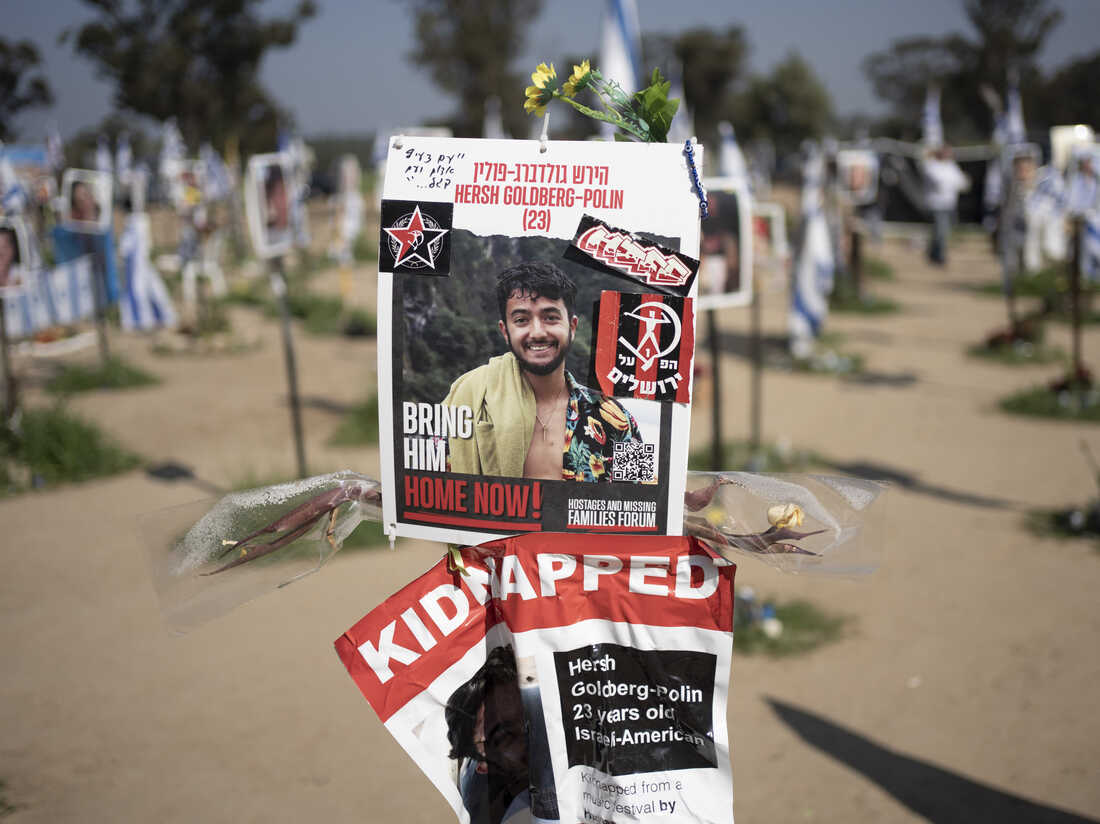An American hostage is seen alive for the first time since Oct. 7 in a Hamas video
A poster depicting Israeli-American hostage Hersh Goldberg-Polin is displayed in Re’im, southern Israel at the Gaza border in February 2024 at a memorial site for the Nova music festival site where he was kidnapped to Gaza by Hamas on Oct. 7, 2023.
Maya Alleruzzo/AP
hide caption
toggle caption
Maya Alleruzzo/AP
A poster depicting Israeli-American hostage Hersh Goldberg-Polin is displayed in Re’im, southern Israel at the Gaza border in February 2024 at a memorial site for the Nova music festival site where he was kidnapped to Gaza by Hamas on Oct. 7, 2023.
Maya Alleruzzo/AP
A hostage video released Wednesday by the military wing of Hamas appears to show a statement by an American-Israeli man who was kidnapped on Oct. 7, marking the first time the militant group has released a video showing one of the five Americans it is holding captive.
The video is also the first time that Hersh Goldberg-Polin, 24, has been seen alive since the day of the Hamas-led attack on Israel, during which some 1,200 people were killed.
In the video, Goldberg-Polin is seen sitting in a chair against a blank wall. He looks straight into the camera. Clearly visible is the healed stump of what was once his left forearm, amputated just below the elbow.
“I went out to hang out with my friends,” he says in the video, which has been edited. “Instead, I found myself fighting for my life with severe injuries all over my body after I tried to protect myself and other frightened citizens with my body, because there was no one to protect us that day.”
As with other hostage videos previously released by Hamas, Goldberg-Polin criticizes Israeli Prime Minister Benjamin Netanyahu, and he claims that Israeli airstrikes have killed other hostages. The video closes with a message for his family: “I love you so much, and I think about you every day,” he says.
Hostage videos are filmed under duress. It is unclear when the video was filmed, although he refers to his 200 days in captivity and makes mention of “this holiday,” likely Passover. A senior Biden administration official said Thursday that the U.S. government received the video on Monday, two days before its release to the public.
The FBI is reviewing the video for any clues about when it was created, National Security Adviser Jake Sullivan told reporters Wednesday, who added that it was unclear why Hamas had chosen this week to release it.
“I can’t speak to what has caused them to choose to release the video at this time,” Sullivan said. “All I can say is this is an innocent young man being held hostage by a terrorist organization and he should be released immediately without condition and without delay.”
Goldberg-Polin’s parents, Rachel Goldberg and Jonathan Polin, have been prominent voices in calling for the release of the remaining hostages; they have spoken to President Joe Biden and Netanyahu and other international officials. Goldberg spoke to NPR in October, shortly after the attack.
On Wednesday, Goldberg and Polin released a video statement in which they said it was overwhelming to watch the footage of their son and urged negotiators to reach a cease-fire agreement.
“Be brave, lean in, seize this moment and get a deal done to reunite all of us with our loved ones and to end the suffering in this region,” Polin said. Goldberg, speaking directly to her son, said, “If you can hear us, I am telling you, we are telling you we love you.”
On the morning of Oct. 7, Goldberg-Polin was among the thousands of attendees at the Nova rave festival near the Gaza border. When militants attacked the rave, he and others attempted to hide in a bomb shelter, his mother told NPR. The attackers threw grenades into the shelter; one exploded, blowing off part of Goldberg-Polin’s left arm.
He sent his family two WhatsApp messages that morning, Goldberg said: “I love you,” and “I’m sorry.”
Goldberg-Polin is believed to be one of five Americans who remain in captivity by Hamas. He was born in the U.S. before moving to Israel with his family as a child. He holds both American and Israeli citizenship. He was 23 years old when he was kidnapped and has since turned 24.
Militants kidnapped more than 240 people on Oct. 7. More than 100 were released during a seven-day cease-fire late last year. Of the 133 that remain in Gaza, dozens are thought to be dead, Israeli officials say. Israel says that the release of the hostages is a top goal of its military campaign in Gaza, which has killed more than 34,000 Palestinians, according to the Gaza Ministry of Health.
On Thursday morning, in an extraordinary joint statement, President Biden and the leaders of 17 other countries with citizens who are missing or in captivity in Gaza together called on Hamas to agree to a cease-fire deal with Israel.
“We emphasize that the deal on the table to release the hostages would bring an immediate and prolonged ceasefire in Gaza, that would facilitate a surge of additional necessary humanitarian assistance to be delivered throughout Gaza, and lead to the credible end of hostilities,” the statement read.
The release of the video ignited protests in Israel on Wednesday night, including outside of Netanyahu’s home in Jerusalem.
On Thursday, at the plaza near to the Tel Aviv Museum of Art where demonstrators have continuously called for the release of the hostages since October, Israel resident Iris Ganor said the video had lifted her spirits and renewed her energy to call for the captives’ safe return.
“Taking into consideration his injury, to see him alive was wonderful, really. I’m so happy. It gave me more hope than I had before,” said Ganor, who herself survived the Oct. 7 attack while visiting family in kibbutz Nahal Oz. “All of them should be back.”
